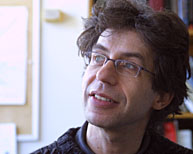Braille for computers
As you read this sentence, you're probably taking for granted the mechanism that allows you to do so with ease: sight. For the blind, reading is made possible with the nearly 200-year-old system of Braille -- six raised dots that the blind run their fingers over to access text through touch, not sight. There are plenty of Braille translations of paper media, but what of computers? How do the blind access the tool that has exploded onto the sighted world?
 Professor Vincent Hayward, director of the Centre for Intelligent Machines
Professor Vincent Hayward, director of the Centre for Intelligent MachinesPhoto: Owen Egan |
|
The Canadian National Institute for the Blind presented Vincent Hayward, Director of the Centre for Intelligent Machines (CIM), the E. and Mary Hochhausen Award for his work towards developing an affordable Braille display for computers. The Hochhausens set up a family trust that gives out $10,000 each year to researchers in adaptive technology for visually impaired or blind people.
"An important component to the computer is the screen," said Hayward at the award presentation in January. "It expresses data in a super-economical manner. I want to touch the equivalent of a screen as we know it."
There are already tools that provide a method of tactile feedback for digital technologies. For instance, blind and visually impaired computer users often rely on audio or magnified visual feedback.
There are also refreshable Braille displays, which are keyboard-like pads upon which you place your hand. These convert computer monitor displays into a line of Braille text, and the user runs his or her finger along the series of Braille dots (computers use groups of eight dots, so that non-letter symbols like @ can be represented).
The displays use up to 80 individual Braille cells, each powered by their own motor. These work well, but cost an awful lot. Although computers are getting cheaper -- you can pick up a decent PC for a thousand bucks -- the displays sell for $9,500 to $17,000.
Hayward and his graduate students, Jerome Pasquero and Vincent Levesque, are working on a Braille display tool that would only be about 2 cm square, and move sort of like a computer mouse. Because the size is so small -- it uses only one cell of two by eight dots -- it will be far less expensive.
There's a cup full of colourful plastic combs above the desks of Pasquero and Levesque, who have been working on a prototype by building tactile devices.
Place your finger along the tips of a comb's teeth. If something presses along the side of the teeth, you can feel the movement at the tip, stretching the skin of your fingers. By grouping the teeth together, a world of sensation can run beneath the fingertips (Levesque has also developed a system to capture the images of the skin response). They've dubbed this technology STReSS -- Stimulator of Tactile Receptors by Skin Stretch.
Pasquero and Levesque look forward to testing out their prototypes with blind computer users. "They don't know if it's going to work, but they're really enthusiastic," Levesque says. "When we try it ourselves, we can't always tell there are two bumps. But they have better sensitivity and can tell right away."
What interests Hayward is that, "If we make it work, it will lead to the question: why does it work?"
Hayward's been working on touch, or haptics, since the early nineties when he started on a project promoted by the company VisuAide to provide blind people with access to a windows-like environment of computers. "We research in a group, and try to think of an immediate application." The Natural Science and Engineering Research Council (NSERC) has been funding him for a decade, and this project is funded by the Institute for Robotics and Intelligent Systems (IRIS).
This is closely linked with Hayward's work in robotics. "It's the same way of thinking -- control feedback, something has to move -- there are a variety of signals." He likens the study of touch to that of the visual or auditory senses, but those areas have readily available tools such as loudspeakers and screens. "When we want to learn something about touch we have to build it," Hayward says. "It's gadget land here," Pasquero laughs. "All over CIM there are devices that whirr, buzz, vibrate, rotate -- you name it."

